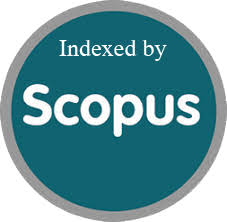Effect of Initial Soil Moisture on Wetting Pattern under Trickle Linear Source in Layered Soil
Abstract
Trickle irrigation is considered one of the main methods in field irrigation. Studying and understanding the moisture distribution pattern beneath the drip irrigation is of great importance to reduce deep percolation losses and the number of emitters. The current study aims to understand the effect of initial soil moisture on the wetting pattern and moisture distribution in layered soils under a linear drip source. The study included tests to monitor the advance of the wetting front during both the wetting phase and moisture redistribution phase over time and for a constant volume of added water using two types of soils, sandy loam and clay, for two conditions of layered soil (sandy loam over clay) and (clay over sandy loam). Water was added at two rates and two levels of initial moisture for each soil type were considered. Empirical equations were derived for estimating both the horizontal surface advance with determination coefficient of )R=0.979( and vertical advance under the trickle source with determination coefficient of ) R=0.979(. The results showed that the ratio of horizontal advance to vertical advance for the wetting front increases with an increase in cumulative infiltration in the layered soil (sandy loam over clay) whhile this ratio decreases with an increase in cumulative infiltration in layered soil (clay over sandy loam). It was also found that the ratio of horizontal advance to vertical advance decreases with an increase in the initial soil moisture of the upper layer and that vertical advance is greater in the case of high moisture compared to low soil moisture for the lowere layer. In addition, the vertical advance in the subsoil isidentical for all cases of initial moisture and water application rates in layered soil (clay over sandy loam) while there is a clear difference in the effect of moisture and water application rate in layered soil (sandy loam over clay).
References
- A. A. M. Al-Ogaidi, A. Wayayok, M. K. Rowshon, and A. F. Abdullah, Wetting patterns estimation under drip irrigation systems using an enhanced empirical model, Agric. Water Manag., vol. 176, pp. 203213, 2016, doi: 10.1016/j.agwat.2016.06.002.
- A. E. Journal, C. C. By, and A. E. Journal, Modeling of Wetting Pattern Under a Linear Drip Source Buried in Layered Soil Al-Rafidain Engineering Journal (AREJ) vol. 27, no. 1, pp. 145152, 2021, doi: 10.33899/rengj.2021.130677.01119
- B. Acar, R. Topak, and F. Mikailsoy, Effect of applied water and discharge rate on wetted soil volume in loam or clay-loam soil from an irrigated trickle source, African Journal of Agricultural Research., vol. 4, no. 1, pp. 049054, 2009. http://www.academicjournals.org/AJAR
- B. M. Ade, K. M. R. Hassan, M. A.Reza, and Y. Morteza, Wetting pattern inspection on steep lands of fath-ali plain in Moqan, ICID 21st Int. Congr. Irrig. Draing Iran, 2011. https://icid.org/Tehran_Congress_Call_for_Papers.pdf
- E. G. Youngs, P. B. Leeds-Harrison, and A. Alghusni, Surface Ponding of Coarse-textured Soils under Irrigation with a Line of Surface Emitters, Journal of Agricultural Engineering Research, vol. 73, no. 1, pp. 95100, May 1999, doi: https://doi.org/10.1006/jaer.1998.0392.
- G. Ainechee, S. Boroomand-Nasab, and M.Behzad, Simulation of soil wetting patternunder point source trickle irrigation., J.Appl. Sci., vol. 9, no. 6, pp. 11701174, 2009,doi: 10.3923/jas.2009.1170.1174
- H. I. Yasin and A. Y. Al-Dabagh, Effect ofIntermittent Water Application from TrickleSource on The Water Movement andMoisture Distribution in Layered Soil,Tikrit J. Eng. Sci., vol. 27, no. 4, pp. 8797,2020, doi: 10.25130/tjes.27.4.09.
- H. I. Yasin and Z. A. Sulaiman and Y. T.Abdul-Baki, Effect of soil bulk density onwetting front advance under a trickle linesource Anbar Journal for EngineeringSciences, no. January, 2010, doi:10.37649/aengs.2010.14212
- H. I. Yasin, M. T. Mahmood, and Z. A.Sulaiman, The Impact of Changes in SoilBulk Density with Depth on the Advance ofthe Wetting Front Damascus UniversityJournal of Engineering Sciences Volume(28), Issue 2, 2012. https:// www.damascusuniversity.edu.sy/mag/eng/images/stories/2-2012/A/327-334.
- H. Moncef and Z. Khemaies, An analytical approach to predict the moistened bulb volume beneath a surface point source, Agric. Water Manag., vol. 166, pp. 123129, 2016, doi: 10.1016/j.agwat.2015.12.020.
- H. Moncef, D. Hedi, B. Jelloul, and M. Mohamed, Approach for predicting the wetting front depth beneath a surface point source: Theory and numerical aspect, Irrig. Drain., vol. 51, no. 4, pp. 347360, 2002, doi: 10.1002/ird.60.
- I. D. Moore and J. D. Eigel, Infiltration into two-layered soil profiles., Trans. Am. Soc. Agric. Eng., vol. 24, no. 6, pp. 14961503, 1981, doi: 10.13031/2013.34480.
- J. Li and Y. Liu, ScienceDi rect Wetting Patterns and Nitrate Distributions in Layered-Textural Soils Under, Article in Agricultural Sciences in China August 2007 vol. 2927, no. January 2018, doi: 10.1016/S1671-2927(07)60136-9.
- M. E. Jensen, Design and operation of Farm irrigation systems. American Society of Agricultural & Biological Engineers, 1983.
- M. R. Goyal, Sustainable Micro Irrigation: Principles and Practices, Apple Academic Press. [Online]. Available: https://doi.org/10.1201/b17155.
- M. S. M. Amin and A. I. Ekhmaj, DIPAC-Drip Irrigation Water Distribution Pattern Calculator, 7th Int. micro Irrig. Congr., no. April, pp. 503513, 2006. https://www.researchgate.net/publication/266862730.
- M. T. Mahmood and H. E. Yassen, Advanceof Wetting Front in Silt Loam Soil under aTrickle Line Source, Tikrit Journal ofEngineering Sciences, vol. 18, no. 2, pp. 117, Jun. 2011, doi: 10.25130/tjes.18.2.09.
- M. T. Mahmood and H. I. Yasin, Devising a mathematical model for displacement estimation of the wetting pattern center from the emitter location resulting from the soil surface slope, Tikrit Journal of Engineering Sciences. 2022. doi: 10.25130/tjes.29.4.5.
- M.A. Sulaiman and H. I. Yasin, Effect of soil surface slope on the performance of trickle line source:(A) wetted pattern, Al-Rafidain Engineering Journal (AREJ), vol. 22, no. 5, pp. 113, 2014, doi: https://doi.org/10.33899/rengj.2014.100996.
- N. Lazarovitch, M. Poulton, A. Furman, and A. W. Warrick, Water distribution under trickle irrigation predicted using artificial neural networks, J. Eng. Math., vol. 64, no. 2, pp. 207218, 2009, doi:10.1007/s10665-009-9282-2.
- P. J. Thorburn, F. J. Cook, and K. L. Bristow, Soil-dependent wetting from trickle emitters: implications for system design and management, Irrig. Sci., vol. 22, no. 34, pp. 121127, 2003.
- Picking D, Soils .MCA Version 1 Massachusetts Arborist Association, Inc. 2005. https://www.umass.edu/larp/pdf/chapter_2_soils_final.
- Q. Bakir and H. Yasin, Wetting Pattern for ATwo-Line Trickle Source, AL-RafdainEngineering Journal (AREJ), vol. 24, no. 1,pp. 5665, Oct. 2019, doi:https://doi.org/10.33899/rengj.2019.163116.
- R. J. Hanks and G. L. Ashcroft, 1976, Physical properties of soils. Department of Soil Science and Biometerology Logan Utah.
- R. Leconte and F. P. Brissette, Soil moisture profile model for Two-Layered soil based on sharp wetting front approach, Journal of Hydrologic Engineering, vol. 6, no. 2, pp. 141149, Apr. 2001, doi: 10.1061/(asce)1084-0699(2001)6:2(141.
- S. Elmaloglou and N. Malamos, Estimation of the wetted soil volume depth, under a surface trickle line source, considering evaporation and water extraction by roots, Irrig. Drain. J. Int. Comm. Irrig. Drain., vol. 54, no. 4, pp. 417430, 2005. doi: 10.1002/ird.193








